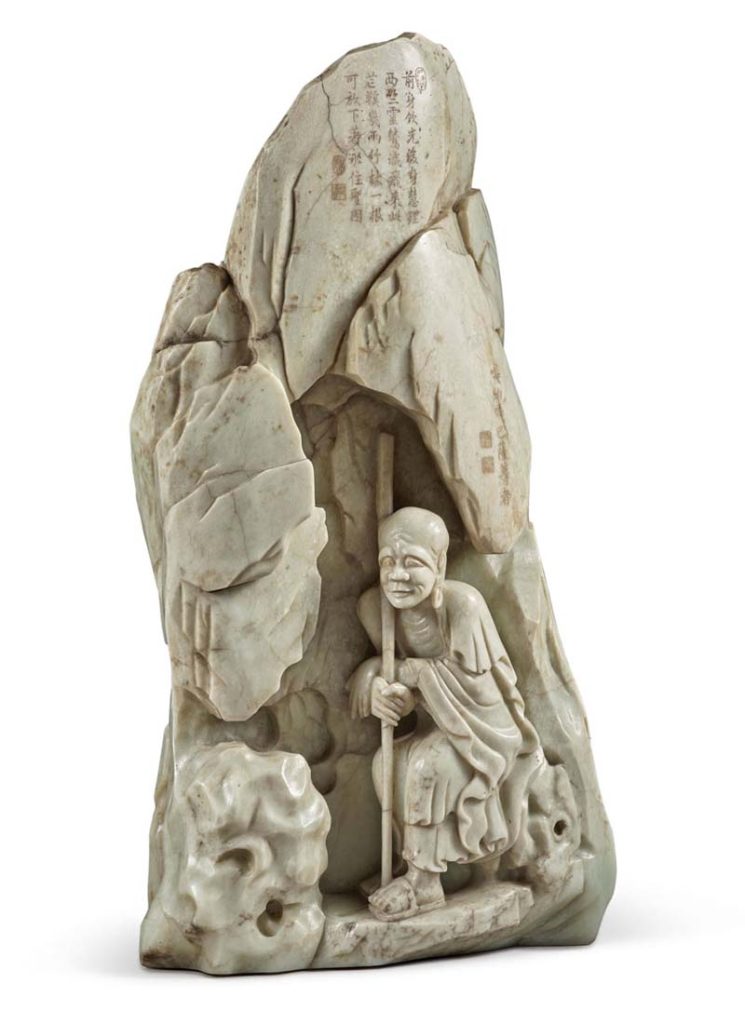
A Large Inscribed Jade Luohan Grotto, Qianlong period (1736-1795), lot 24, the Dr Wou Kiuan Collection
A Journey Through China's History: The Dr Wou Kiuan Collection Part 1
Sotheby's
On sale Tuesday, March 22 at 9am
This March, Sotheby’s will present Part 1 of one of the most comprehensive collections of Chinese Art ever assembled, The Dr Wou Kiuan Collection. Celebrating over 4,000 years of Chinese culture and art history, this distinguished encyclopedic collection ranges from Neolithic utilitarian vessels to paintings, calligraphy, imperial jades and porcelain, and more. The New York auction will be the first of a series of four single-owner sales to be held globally and represent the finest examples of virtually every category of Chinese art.
The collection of Dr. Wou Kiuan was long tucked away in a discreet corner of the southern British Isles. Across seven interconnecting rooms displayed a comprehensive visual history of China. Covering some 4,000 years of Chinese art, the collection formed by Dr. Wou Kiuan (1910-1997) ranges from utilitarian storage vessels made by the first Neolithic cultures that emerged along the Yellow River to the most dazzling porcelains ever commissioned to adorn the palaces of the Qing Emperors of China’s final dynasty. The extraordinary scope of the collection sets it apart from all other private collections of Chinese art formed in the mid-20th century, and it remains one of the last great collections of Chinese art in Europe today.
The uniquely comprehensive collection was formed by Wou Kiuan (Wu Quan, Heng Zhi), son of the Republican politician Wou Lien-Pai (Wu Jinglian, Wu Lianbo) (1873-1944). Wou Kiuan was born in Xingcheng, Liaoning Province in Northeast China on June 25, 1910, entering the world mere months before the overthrow of the Qing dynasty. Educated at Zhendan University in Shanghai, Wou Kiuan studied French language before he moved to France at the age of twenty to study law at the University of Grenoble and was awarded his doctorate degree from the Sorbonne in Paris. Appointed Secretary-General for the Overseas Chinese Committee at the League of Nations in Geneva in 1937, Wou embarked on an illustrious career in diplomacy. In 1939, he joined the newly-formed Chinese government Foreign Affairs Service at the French embassy in Paris; before moving to London in 1941 where he worked for the Chinese embassy in London until 1947 when he was recalled to China to serve in the Ministry for Foreign Affairs until his retirement in 1952.
At the heart of Dr Wou’s drive to collect was a burning desire to preserve the relics of China’s rich historical past scattered across Europe and to promote Chinese art and culture. It was no doubt fortuitous that Wou’s years of collecting coincided with an abundant availability of exceptional Chinese art on the London market. From the mid-1950s to late 60s he was able to form a collection of well over 1,000 works that together represented virtually every category of Chinese art. In 1968 he opened the doors to the Wou Lien-Pai Museum, named in honor of his father. The collection was arranged chronologically, with the objects displayed in wood-framed vitrines, each accompanied by typed and handwritten didactic texts. Over the years the Museum became a destination for collectors, academics, and visiting dignitaries. To this day the Wou family has remained a conscientious custodian of the collection, loaning works to exhibitions and publishing a two-volume catalogue in 2011, thereby continuing to educate future generations.
Read more, click here
